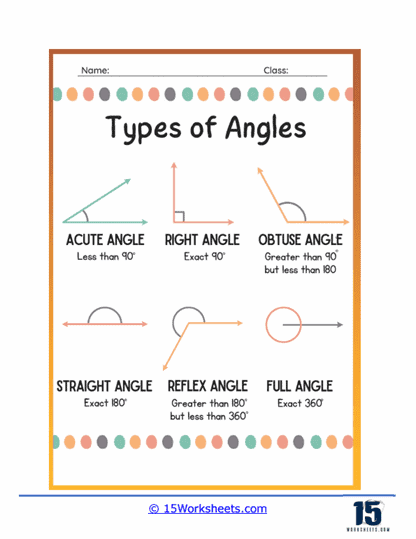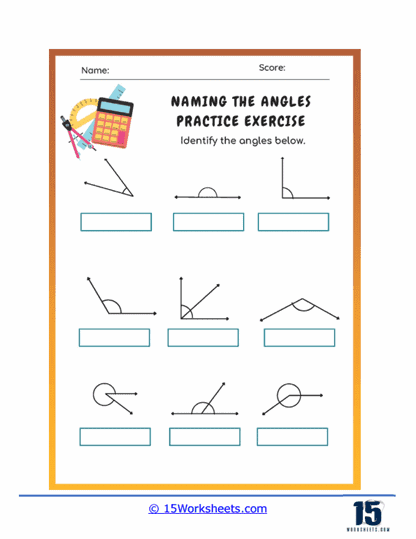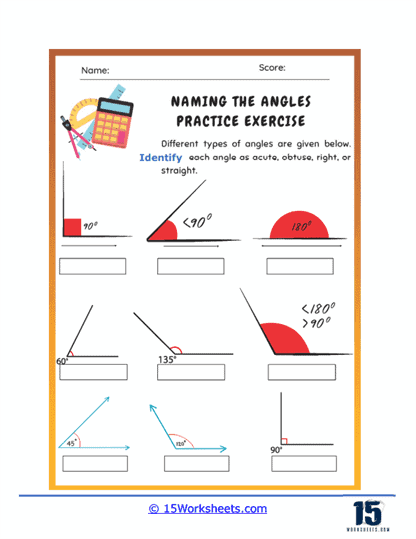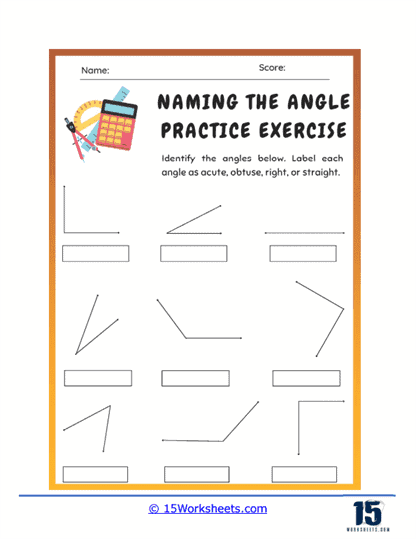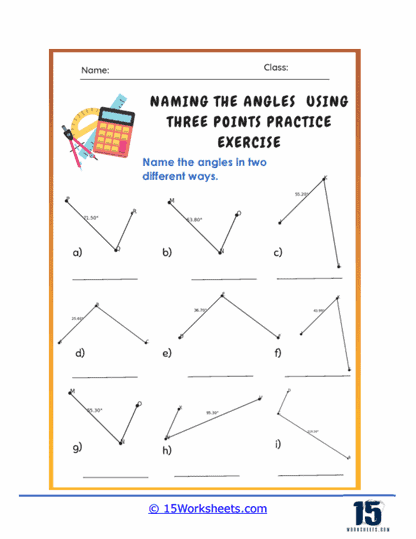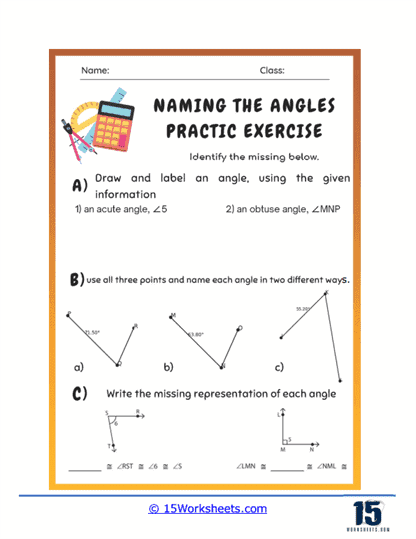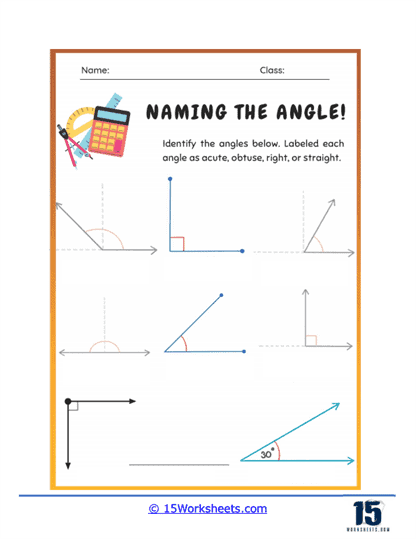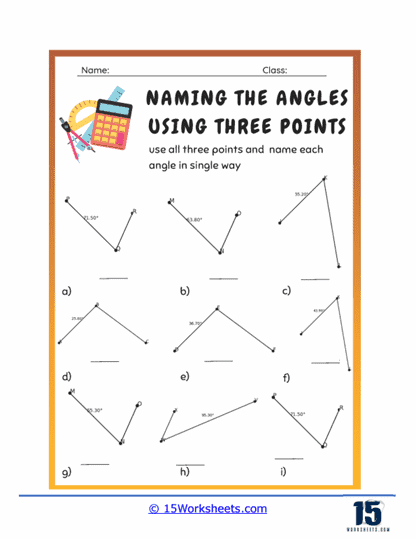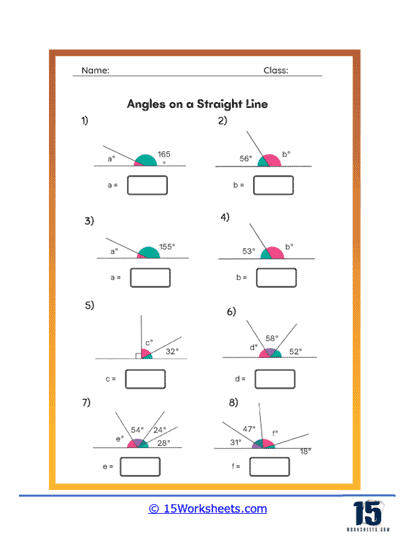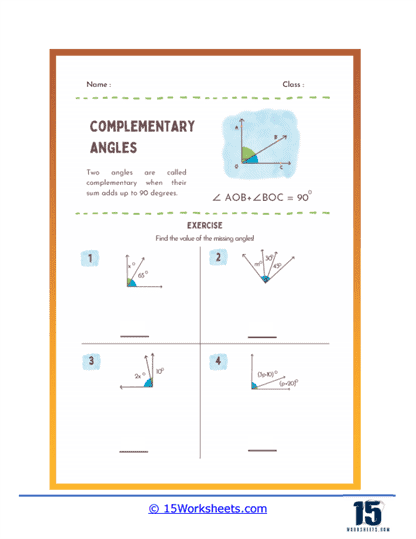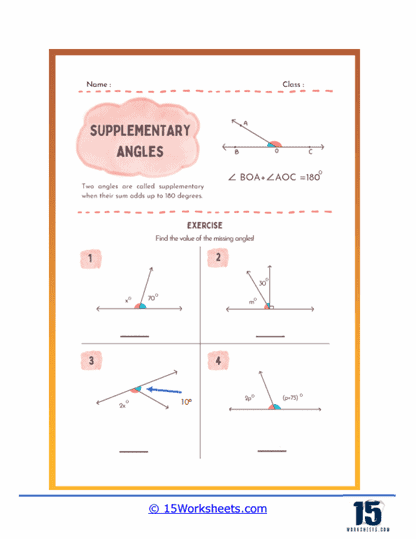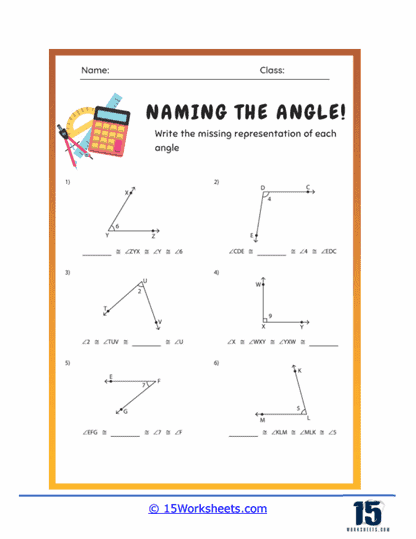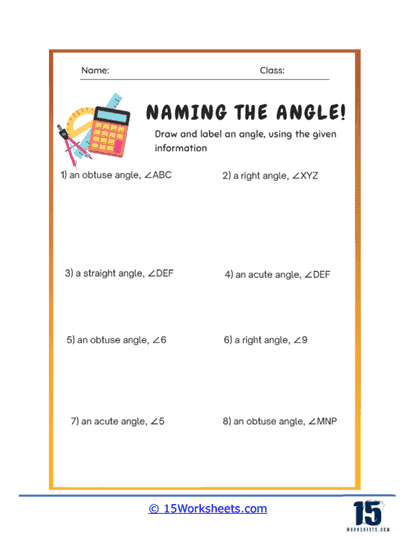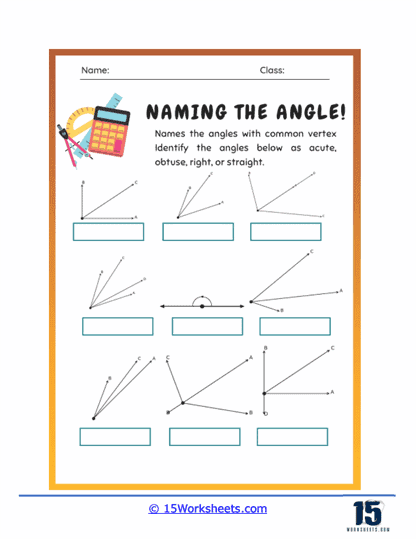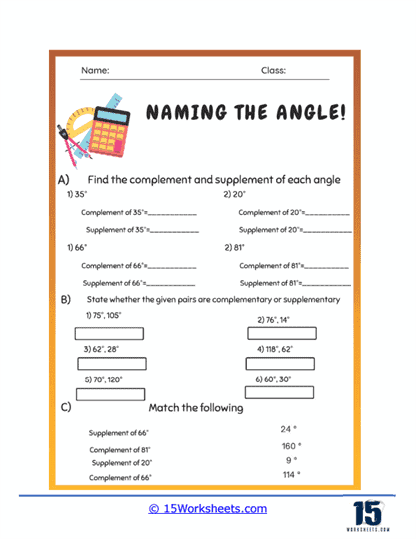Naming Angles Worksheets
About These 15 Worksheets
These worksheets will help students understand and identify different types of angles. These worksheets are designed to teach students how to recognize, name, and categorize angles based on their measurements. By working through various exercises and practice problems, students develop a solid foundation in geometry, which is crucial for more advanced mathematical concepts.
One of the primary math skills explored in naming angles worksheets is the ability to identify angles by their size. Students learn to differentiate between acute, obtuse, right, and straight angles. Acute angles are those that measure less than 90 degrees, while obtuse angles measure more than 90 degrees but less than 180 degrees. Right angles are exactly 90 degrees, and straight angles are 180 degrees. Through repeated practice, students become adept at visually estimating and measuring these angles, reinforcing their understanding of these fundamental geometric concepts.
A common exercise found in naming angles worksheets involves identifying and labeling angles in various shapes and diagrams. Students are presented with different geometric figures, such as triangles, quadrilaterals, and other polygons, and are asked to label each angle as acute, obtuse, right, or straight. This task not only helps students practice identifying angles but also encourages them to consider the context in which angles appear. By working with different shapes, students learn how angles relate to one another and how they combine to form larger geometric structures.
Another typical exercise involves measuring angles using a protractor. Students are given diagrams with unmarked angles and are asked to measure each angle using a protractor. This hands-on activity helps students develop the skill of precise measurement and reinforces their understanding of angle sizes. Additionally, by comparing their measurements with the expected angle types, students can check their work and gain confidence in their ability to measure and identify angles accurately.
Naming angles worksheets often include exercises that require students to draw specific types of angles. For instance, a worksheet might ask students to draw an acute angle, an obtuse angle, a right angle, and a straight angle. This activity challenges students to apply their knowledge creatively and helps them develop their drawing skills. By practicing drawing different angles, students improve their spatial awareness and gain a better understanding of the characteristics that define each type of angle.
Naming angles worksheets can include more complex problems that involve calculating the measures of unknown angles. For example, students might be given a diagram of a triangle with one angle measurement provided and asked to calculate the other two angles. This type of problem requires students to apply their knowledge of angle properties and relationships, such as the fact that the sum of the interior angles of a triangle is always 180 degrees. By solving these problems, students strengthen their problem-solving skills and deepen their understanding of geometric principles.
Another type of exercise commonly found in naming angles worksheets is the identification of angles in real-world contexts. Students might be presented with pictures or diagrams of everyday objects, such as a book, a clock, or a piece of furniture, and asked to identify the types of angles they see. This activity helps students make connections between abstract geometric concepts and the real world, reinforcing the relevance of their learning. By recognizing angles in their environment, students develop a more intuitive understanding of geometry and its applications.
Naming angles worksheets also often include matching exercises, where students match angle names to their corresponding measurements or diagrams. For example, a worksheet might present a list of angle types (acute, obtuse, right, straight) alongside a series of angle measurements or diagrams, and students must draw lines connecting each name to the correct measurement or diagram. This activity reinforces students’ ability to recognize and categorize angles and provides immediate feedback on their understanding.
Some worksheets incorporate activities that involve finding complementary and supplementary angles. Complementary angles are two angles whose measures add up to 90 degrees, while supplementary angles add up to 180 degrees. Students might be given a series of angle pairs and asked to determine whether they are complementary or supplementary. This exercise helps students understand the relationships between angles and develop their ability to work with angle measures in more complex contexts.
Naming angles worksheets can also include problems that involve identifying and working with adjacent and vertical angles. Adjacent angles share a common side and vertex, while vertical angles are formed by two intersecting lines and are opposite each other. Students might be asked to identify these types of angles in diagrams or to use their properties to solve for unknown angle measures. By working with adjacent and vertical angles, students learn about important geometric relationships and develop their analytical skills.
Some worksheets challenge students to explore angles in polygons. For example, students might be asked to identify and label all the angles in a given polygon or to calculate the sum of the interior angles of a polygon. This type of problem requires students to apply their knowledge of angle properties and relationships to more complex geometric figures. By working with polygons, students develop a deeper understanding of how angles interact within different shapes and gain experience with more advanced geometric concepts.
Naming angles worksheets often incorporate word problems that require students to apply their knowledge of angles to real-life scenarios. For example, a word problem might describe a situation where a person is measuring angles to build a piece of furniture or to design a garden layout. Students must use their understanding of angles to solve the problem and determine the correct measurements. This type of exercise helps students see the practical applications of their learning and develop their problem-solving skills.
These worksheets can include interactive activities and games. For example, students might play a game where they must identify and name angles within a certain time limit or work in pairs to measure and label angles in a collaborative activity. These interactive elements make learning about angles more engaging and enjoyable, helping students to stay motivated and retain the information they learn.
To provide a comprehensive learning experience, naming angles worksheets often include review and assessment sections. Students might be given a series of problems that cover all the concepts they have learned, allowing them to review and reinforce their knowledge. Assessment sections can include quizzes or tests that evaluate students’ understanding of angle identification, measurement, drawing, and calculation. These review and assessment activities help ensure that students have a solid grasp of the material and are prepared to move on to more advanced geometric concepts.
Naming angles worksheets are versatile educational tools that can be adapted to different grade levels and learning styles. For younger students, worksheets might focus on basic identification and drawing exercises, while more advanced students might work on complex calculations and real-world applications. Teachers can also differentiate instruction by providing worksheets with varying levels of difficulty, ensuring that all students are appropriately challenged and supported in their learning.
These worksheets play a crucial role in helping students develop a strong foundation in geometry. By working through a variety of exercises and practice problems, students learn to recognize, name, and categorize angles, as well as to measure, draw, and calculate angle measures. These skills are essential for understanding more advanced geometric concepts and for applying geometry in real-world contexts. Through consistent practice and reinforcement, students build confidence in their abilities and develop a deeper appreciation for the beauty and utility of geometry.
How This Skill Is Used In Real World
Naming angles plays a significant role in the real world, impacting various fields and everyday activities. Understanding angles and being able to identify and name them correctly is crucial in architecture, engineering, art, navigation, sports, and even in simple tasks around the home. By learning to name angles, students develop spatial awareness and analytical skills that are applicable in numerous real-life situations.
In architecture and construction, naming angles is essential for designing buildings and structures. Architects and engineers must calculate precise angles to ensure the stability and aesthetic appeal of buildings. For example, the angle of a roof, the slope of a staircase, and the corners of rooms are all determined by specific angle measurements. Builders and carpenters use tools like protractors and angle finders to measure and cut materials at accurate angles, ensuring that everything fits together correctly. When students understand angles, they can appreciate the complexity and precision involved in creating safe and functional structures.
In navigation and geography, angles are fundamental for determining directions and plotting courses. Pilots, sailors, and even hikers use angles to navigate from one point to another. Compasses and maps often require users to measure and understand angles to find the correct route. For example, a sailor might need to adjust their course by a specific angle to reach their destination. By learning to name and measure angles, students gain skills that are vital for understanding maps, using GPS devices, and finding their way in unfamiliar places.
In sports, angles play a crucial role in strategy and performance. Athletes and coaches analyze angles to improve techniques and make strategic decisions. For instance, in basketball, players consider the angle of their shots to increase the likelihood of scoring. In soccer, players think about the angles of their passes and shots to outmaneuver opponents. Understanding angles helps athletes optimize their movements and make better decisions during gameplay. By learning about angles, students can enhance their athletic performance and better understand the dynamics of their favorite sports.
In the field of art and design, angles are integral to creating visually appealing and structurally sound works. Artists and designers use angles to achieve balance, symmetry, and perspective in their creations. For example, graphic designers work with angles to create logos and layouts that are visually pleasing and functional. In drawing and painting, understanding angles helps artists accurately depict three-dimensional objects on a two-dimensional surface, creating the illusion of depth and realism. By mastering the naming and measurement of angles, students can improve their artistic skills and appreciate the geometric principles behind great works of art.
In everyday life, angles are encountered in numerous routine activities. When hanging a picture frame, measuring the angle ensures it is level and aesthetically pleasing. DIY enthusiasts often need to cut materials at specific angles to complete home improvement projects, such as building shelves or assembling furniture. In cooking, certain recipes require cutting ingredients at particular angles for even cooking or presentation. Understanding angles makes these tasks more straightforward and ensures better results. By learning to name and measure angles, students can tackle these everyday challenges with confidence and precision.
Naming angles is a fundamental skill with broad applications in the real world. From architecture and engineering to art, sports, navigation, and everyday tasks, understanding angles enhances our ability to interact with and shape our environment. By learning to name, measure, and understand angles, students develop essential skills that prepare them for a wide range of careers and activities. These skills not only improve their academic performance but also empower them to tackle practical challenges and appreciate the geometric principles that govern the world around them.

